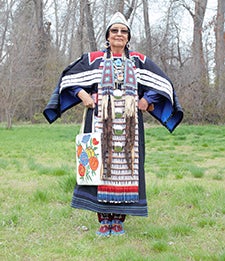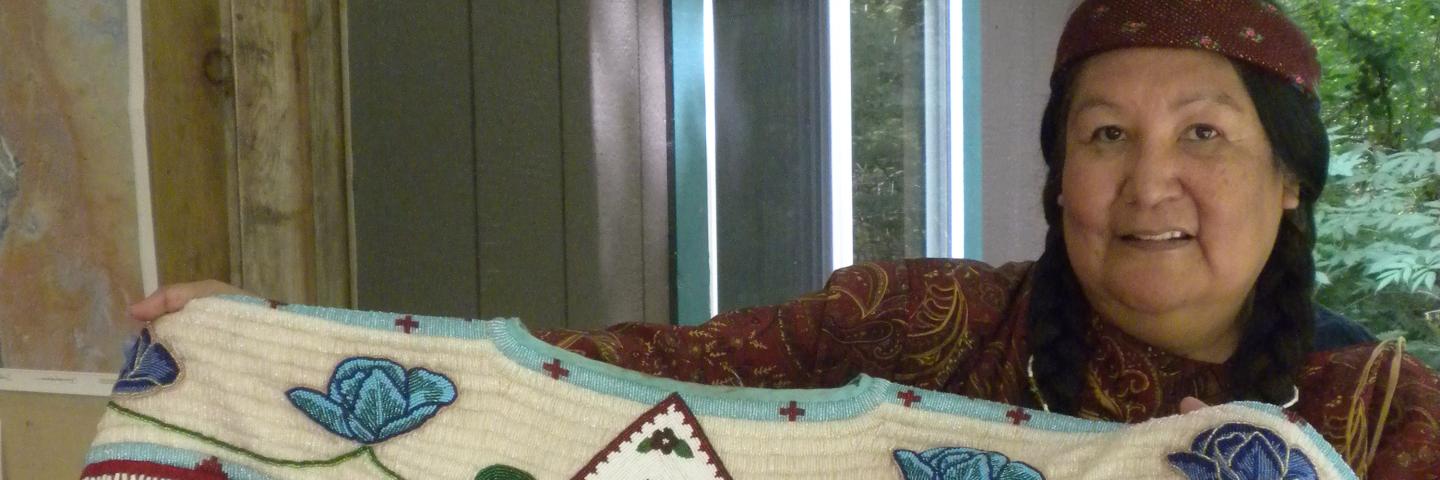 | Traditional Skill/Art: Plateau Beadwork Years Awarded: 2014, 2016, 2019 Contact Information: Phone: (541)553-3465 Email: hklumiat@hotmail.com |
ARTIST BIOGRAPHY
My Indian name is H’Klumaiyat and I am Wasco, Warm Springs on my mother’s side and Dine’ on my father’s side. I am enrolled and have been raised with my mother’s tribe, the Confederated Tribes of Warm Springs Reservation of Oregon. I am a traditional food gatherer for the Simnasho Longhouse and this includes digging for the Root Feast and picking huckleberries for the Huckleberry Feast.
I studied museology and three-dimensional arts at the Institute of American Indian Arts, Sante Fe, NM and completed in 1985.
I have been working in museum related areas since then and also still doing beadwork and longhouse fashion design as my artistic expression. I have worked as Registrar for our museum at Warm Springs and then worked at the National Museum of the American Indian (NMAI) as a Museum Specialist where I oversaw the Traditional Care component of NMAI’s collection. I now work in our tribe’s Cultural Resources Department as the NAGPRA Coordinator and Review and Compliance Coordinator.
I have practiced traditional arts and sewing since I was a young girl. I know how to make men’s and women’s outfits for powwow, longhouse, traditional social dancing and burial.
When I make anything, I try to make it the best I can. I have beaded two dresses which are fully beaded and both have accessories. I have two granddaughters which these dresses will be passed down to.
APPRENTICE BIOGRAPHY - MARIA GODINES 2019
Maria Godines, also known as Mnuwai Ayat (Kind Woman) is part of the Warm Springs and Wasco people indigenous to Oregon. She learned how to bead at a young age by her sister then was taught how to sew by her other sister and mother. Her family has taught her various cultural arts that she is turn has taught her children and grandchildren these cultural art forms. Although she already has a wealth of cultural knowledge and skill in traditional arts, she is working with Roberta Kirk to learn different techniques and traditional arts. Her work with Roberta Kirk was to cut, sew and bead a man’s ceremonial outfit that they would wear inside the longhouse during traditional Waashat services.
APPRENTICE BIOGRAPHY - MATILDA WALLULATUM 2016
Matilda Wallulatum is a member of the Confederated Tribe of the Warm Springs here in Oregon. She is a traditional food gatherer at the Simnasho longhouse where she gathers and prepares the food for Sunday services, there she also dances and has been learning Washut songs. She is a traditional artist with many skills including moccasin making, traditional earrings, and the making of a traditional jingle dress. Her work with Roberta Kirk is working on dentalium piecework, specifically dentalium hair ties and breastplate necklaces.
APPRENTICE BIOGRAPHY - LUCINDA SOHAPPY 2016
Lucinda Sohappy is a member of Confederated Tribe of the Warm Springs here in Oregon who moved to the Warm Springs reservation when she was in 8th grade and strives to learn as much about her culture and traditional art forms as possible to pass onto her own children. She previously has worked with Roberta Kirk in making traditional burial outfits and moccasins. Her work here with Roberta is learning how to work with dentalium in hopes to create wedding veils, breastplates and other cultural items. She is currently teaching painting classes in a workshop at the Museum of Warm Springs.
APPRENTICE BIOGRAPHY - ANNIE KIRK 2014
Annie Kirk (T’Quananmy) is a member of the Confederated Tribe of the Warm Springs. She is a self-taught bead worker but also learned traditional arts from her mother. Her work with Roberta Kirk is to make shell dresses which are important ceremonial regalia. Her goal is to learn how to make dance regalia and to teach her family how to bead and sew and pass on the traditional arts of her culture.
Q+A WITH THE MENTOR ARTIST
Describe your traditional art.
Body
Plateau Shell Dress (2014): This dress will include floral applique on the shoulder or yoke, front and back, and will also have three rows of dentallium shells in the front and back. This dress is for ceremonies to be worn at the longhouse for feasts or for other ceremonies. During funerals for other food gathers or highly regarded persons, we wear our shell dresses or buckskin dresses in their honor. The shell dress has been used by our people for many many years and it’s typical to adorn it with beads and shells or elk teeth.
The Plateau Tribes lived along the tributaries of the Columbia River and usually spoke a dialect of Ichishkiin or Sahaptin language. We all use longhouses and celebrate First Food Ceremonies such as Salmon Feast, Root Feast and Huckleberry Feast. When presenting ourselves to Creator, we are always supposed to present ourselves in our finest manner and this is where the shell dress has its place.
Dentalium Breastplates (2016): Dentalium shells used to be used as money and it signified wealth and was something that was always sought after. Its sewn on to dresses and also used as wedding veils, hair ties and necklaces or breastplates.
How did you come to learn this tradition?
Body
Plateau Shell Dress (2014): I saw my older sister doing beadwork when I was a child and she showed me how to work on projects.
Sewing, self-taught. I know how to sew and can look at something and figure out how to make it or make a pattern. When I was a young girl, my family’s home burnt down and many priceless treasures burnt up as well such as huckleberry baskets, beaded bags, beaded dresses, and photographs. As I was growing up, I always saw the girls my age wearing beautiful dresses that were passed down from their grandparents and I didn’t have any. My mother was an orphan and raised by her grandmother who was a medicine woman. Everything that was gifted to my mother was burnt in the home fire and so I knew if I wanted anything then I better learn how to make it myself. Since then, I’ve been making ribbon shirts, shell dresses, and beaded buckskin dresses. Accessories such as moccasins, beaded bags, beaded eagle fans, barrettes, and buckskin burial outfits for men, women and children.
Dentalium Breastplates (2016): I am self-taught on using the dentalium shells. I made my first dentalium breastplate about 40 years ago and have been working with the shells ever since.
Why is this cultural tradition important to your community?
Body
Beadwork and regalia making is very important to our people. We always show ourselves to Creator in our finest wear and so we make beautiful clothing for our children and families.
Experience/Honors
Body
2000—Honorable Mention, The Museum at Warm Springs, Beaded Dress “Auuna Waashaa—Let's Go Dance” Dress
2001—Traditional Arts Apprenticeship Program Master artist, Beaded Plateau outfits
2014—Honorable Mention, The Museum at Warm Springs, Beaded Ceremonial Hat “In My Granddaughter's Honor”
2014—Traditional Arts Apprenticeship Program Master Artist, Wasco Floral Dress
2016—University of Oregon Museum exhibit, Wasco Floral Dress with Dentaliums
Visit OFN's Culture Keepers Roster to learn more about the artist.
Traditional Arts Apprenticeship Program
More OFN programs
OFN main page
